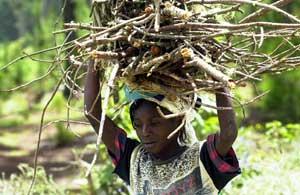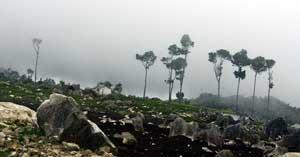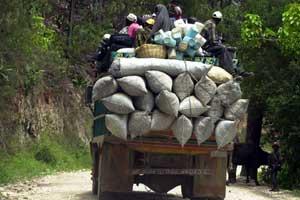| Want to send this page or a link to a friend? Click on mail at the top of this window. |
| Posted August 5, 2003 |
| Forest land in Haiti fading fast; natural resource nudged to the brink |
| BY JANE REGAN Special to The Herald |
SEGUIN, Haiti -- Desperate to survive, Haitians are slowly gnawing away at their last one percent of forest, turning trees in state preserves into lumber, firewood and charcoal and burning the grounds to plant vegetable patches.
Government officials meanwhile squabble over the proper policy to protect what little is left, and park rangers complain they are too few to halt the forests' destruction -- even as trucks loaded with charcoal pass their checkpoints.
It's enough to make 12-year-old Wilfred Exantus angry as he recently watched a fire set by a neighbor so that he could push his illegal vegetable garden deeper into the La Visite Park.
 |
 |
||
| TAKING COVER: A young girl carries pine branches torn from trees in La Visite Park, a reserve outside Port-au-Prince. Daniel Morel/Special to the Herald | BARREN: A house sits amid a field of rocks where trees once stood. Daniel Morel/Special to The Herald |
''They do it because they need money,'' Exantus said, a simple but brutal reality in a country where the average person survives on less than $1 a day.
Most of the remaining trees in Haiti, about 75 percent forested before Europeans arrived in 1492, are located in two parks and one forest reserve, including the La Visite Park and nearby Pine Forest Reserve, which together cover 77,000 acres high in the La Selle mountain range south of Port-au-Prince. The third park, Pic Macaya, sits on 13,500 acres in mountains to the southwest.
The parks were created by former dictator Jean-Claude Duvalier in 1983. But even his feared regime didn't stop the cutting.
Almost 20 years of political turbulence only compounded the problem, with the economy faltering and poverty growing. This year, the country dropped on the U.N. Human Development Index ranking, from 146th to 150th among 175 nations.
EFFORTS FALTER
Efforts to save Haiti's forests have met with little success over the years.
Among them was a $22.5 million World Bank project, its first environmental loan to the devastated country. Haitian Minister of Environment Webster Pierre suspended the project soon after taking office in 2001. ''It wasn't my vision,'' he explained.
 |
| ROLLING ALONG: A truck carrying peasants and bags of freshly made charcoal rumbles through the Pine Forest Reserve. Daniel Morel/Special to The Herald |
But before his ministry could decide what to do, the World Bank canceled the project altogether. A bank report last year said ''there is no evidence that [the project] slowed the pace of degradation of natural resources'' and deplored high ministerial turnover, lack of commitment and inter-agency squabbling.
''The government wasn't particularly committed,'' said the bank's Elizabeth Monosowski, who was the project's manager, in a telephone interview from Washington, D.C.
Four decades after the forest preserves' creation, no centralized agency has been established to run them. Today four Haitian ministries -- agriculture, tourism, environment and planning -- argue over how they should be run.
A 1998 French Spot XS satellite study put Haiti's forest cover at only 1.25 percent, and at last year's Earth Summit, President Jean-Bertrand Aristide said that number had dropped to 1 percent.
ECOSYSTEMS IN DANGER
Meanwhile, deforestation in Haiti -- described by one recent U.N. report as ''one of the most degraded countries in the world'' -- also threatens its mountain ecosystems.
The La Selle range is home to a number of birds and plants that do not exist anywhere else. A survey three years ago found that many native birds, including the Hispaniolan Parrot and Parakeet, Chat Tanager and White-Winged Warbler, were in danger of disappearing.
''They are unique to the world and contribute to a long evolutionary history of the Caribbean,'' said Florence Sergile, co-author of several studies on Haiti's flora and fauna.
If the cutting continues, many endemic species will become extinct, Sergile said in an e-mail from her home in Gainesville.
Sergile also said Haiti's tree ''gene pool'' has already been seriously eroded because so many healthy ones have been cut, leaving mostly smaller, weaker ones to reproduce.
The cutting is also threatening one of the country's last forested watersheds, since La Visite Park's wooded peaks capture precious raindrops for Haiti's capital as well as major agricultural areas north and south of the range.
On a recent afternoon at the Pine Forest Reserve, a steady stream of peasants carried freshly harvested potatoes, carrots and cabbages out of the forest, walking past rows of trees whose trunks were blackened.
Wilner Jean, 52, and two other agents played cards at the gate house, getting up occasionally to check passing trucks for illegal shipments of cut trees.
''There are only six of us, two teams of three. We are supposed to man this post and also cover the terrain,'' about half the reserve, or almost 40,000 acres, he said.
``What that means in reality is that there are no guards in the forest. Zero. People can cut wood. People can plant cabbage. People can do whatever they want.''
Over the course of two hours, six trucks piled high with charcoal -- made from trees -- rumbled out of the park. The agents made a cursory search for planks but hardly glanced at the sacks, saying the charcoal could have been made outside the reserve limits.
PROTECTION PLAN
Minister of the Environment Pierre said he disagrees with a ''billy-club'' method of protecting the parks. Instead, he wants peasants living in the forests to continue to live there, growing vegetables and looking after trees in exchange for $1.20 per tree per year. He said so far the rest of the government hasn't bought into his idea.
''I put the plan on the Internet; I've talked about it on the radio. That's all I can do,'' he said, throwing up his hands.
Now he is looking to the Haitian diaspora. ``All I ask is one dollar per person per year. No more.''
In the meantime, Pierre is proud of a new cadre of 1,045 paid ''environmental agents'' who are intended to educate the population about the value of Haiti's forests.
But Jacmel chemistry professor Wesner Jean, who coordinates agents in his region, including La Visite Park, admitted that without police backup, the agents, armed only with leaflets and posters and paid about $60 per month, can't stop tree-cutters.
Ronel Ceran, a consultant currently with the United Nations who worked for the Environment Ministry when it was first established in the 1990s, dismissed the agents' effectiveness.
More money, more agents and more microprojects are not the answer, Ceran said. ''As long as the political crisis isn't resolved . . . the level of corruption in this country is so high that nothing is possible in terms of long-term effect,'' he said.
In Port-au-Prince, thousands of sacks of charcoal and kindling and scores of trucks piled high with pine, avocado, mango and apricot wood for building, cooking and dry-cleaning clog the markets.
Wesner Pierre-Louis, 46, supports his family by selling pine planks. He said he knows deforestation damages the environment.
''But if the government doesn't want wood to be cut, it should stop the peasants,'' he said. ``If a peasant brings me wood, I'll sell it.''
Reprinted from The Miami Herald of August 5, 2003.
| Wehaitians.com, the scholarly journal of democracy and human rights |
| More from wehaitians.com |